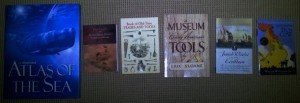 There’s no rule about how to organize your own book collection, but National Public Radio listeners had some interesting suggestions:
There’s no rule about how to organize your own book collection, but National Public Radio listeners had some interesting suggestions:
[M]y presidential biographies … are all in the order that the presidents served.
I have my books arranged on my bookshelf by color, which works for me.
I sneaked the library’s copy of An Introduction to Cataloging and the Classification of Books back to my room and puzzled out simplified Dewey numbers and taped them onto the spines of my books.
Check out the full story here!
When I moved to DC, I considered using the Library of Congress system, since my books range across the entire spectrum of subjects. In the end, I decided on a few broad categories, broken into sub-categories based on the number of books I have in each. My main goal was to have the books organized thematically shelf-by-shelf, so that no shelf contained mixed subject matter. Space left empty on a shelf due to this subject-matter restriction just means, “Buy more books about this!”
The current breakdown might tell you a little about me:
1 shelf of hard-boiled fiction, including everything Chandler ever wrote
2 shelves of fantasy, sci-fi, and modern realist fiction
1 shelf of classics and poetry
3 shelves of books about writing
1 shelf of archaic dictionaries (e.g., colonial American English, Civil War terminology, Shakespeare’s vocabulary, Samuel Johnson, etc.)
2 shelves of foreign language references (e.g., Arabic, Hebrew, Hindi, Hawaiian, Samoan, Spanish, Latin, etc.)
1 shelf of ancient history and archaeology
3 shelves of Abrahamic religion (Judaism-Christianity-Islám), history, and philosophy
2 shelves of world religions and religious history (i.e., everything other than Abrahamic)
1 entire bookcase (4 shelves) plus 2 shelves in another bookcase of early modern history (e.g., age of sail, pre-industrial mercantile culture, etc.)
1 shelf of philosophy (e.g., Nietzche, The Federalist Papers, Confucius, Machiavelli, etc.)
1 shelf of general history and historical biography
1 shelf of physics, astronomy, and scientific theory
1 shelf of military history and theory
2 shelves of regional and topical photography (e.g. deserts, oceans, the Arctic, rain forests, Tanzania, 19th century Polynesia, historical Charleston, etc.)
1 shelf of atlases
3 shelves of political science and sociology
3 shelves of psychology and behavioral economics
1 barrister case (4 shelves) filled with legal texts (e.g., law dictionaries, admiralty casebooks, etc.), sexuality, antiques, and miscellanea
